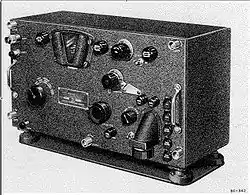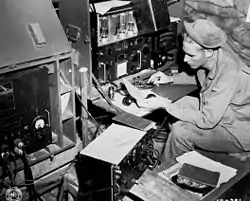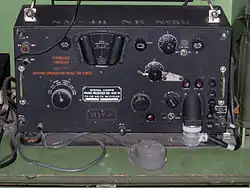BC-342
The BC-342 was a World War II U.S. Army Signal Corps high frequency radio receiver. It was a 115 Volt AC version of the BC-312 receiver that used the RA-20 rectifier instead of the BC-312's DM-21 dynamotor. It was used primarily as part of field installations such as the SCR-188A, but could be used with mobile sets such as the 2 1/2 ton mounted SCR-399. First designed at Fort Monmouth, New Jersey by the U.S. Army Signal Corps, it was built by various manufacturers including RCA. Many of the later units that are encountered today were manufactured by the Farnsworth Television and Radio Corporation of Fort Wayne, Indiana. Its low frequency counterpart is the BC-344 radio receiver that is almost identical to the BC-342.[1]

Specifications


The BC-342 could be operated from fixed and mobile positions.
- Power - An internal RA-20 AC rectifier power supply unit is fitted providing 250 volts DC and 12 volts AC for the receiver tube filaments (three pairs of the 6 volt tubes are wired in series and three in series / parallel).
- Manual Reference: TM 11-850[2]
- Components: RA-20 Power Supply
- Weight: 58 lbs.
- Frequency Range: 1.5-18 MHz
- Power Input: 110 VAC 60 Hz
- Part of: SCR-197, SCR-237, SCR-277, SCR-299, SCR-399, MRC-1
10 vacuum tubes[3] included:
- RF amplifiers - 6K7 (2)
- Mixer - 6L7
- Local oscillator - 6C5
- IF amplifiers - 6K7 (2)
- CW oscillator (BFO) - 6C5
- Detector/1st AF - 6R7
- Audio output - 6F6
- Rectifier - 5W4
The BC-342 was similar to the BC-348. Heavy chassis design was employed to minimize drift and oscillator instability due to temperature changes and vibration.[4][5]
References
- http://oak.cats.ohiou.edu/~postr/bapix/BC342.htm Archived 2008-08-01 at the Wayback Machine BoatAnchor Pix, Signal Corps BC-342N Receiver
- http://radionerds.com/index.php/850
- http://www.antiqueradio.com/Nov03_DAntuono_BC342.html Antique Radio Classified
- http://www.gordon.army.mil/OCOS/Museum/bc1.asp Archived 2009-02-06 at the Wayback Machine Fort Gordon Military Museum
- http://www.nj7p.org/cgi-bin/millist2?mode=normal&name=BC-342J7P Archived 2011-05-27 at the Wayback Machine Military List Database
External links
 Media related to BC-342, BC-312 receivers at Wikimedia Commons
Media related to BC-342, BC-312 receivers at Wikimedia Commons- Repairing a BC-342
- BC-342 Data Sheet